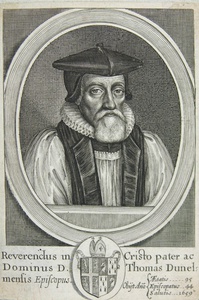| Method | Engraving |
| Artist | William Faithorne |
| Published | c.1659 |
| Dimensions | Image 162 x 105 mm, Sheet 173 x 113 mm |
| Notes |
Portrait of Thomas Morton, Bishop of Durham, bust in an oval, before a parapet, bearded, wearing cap, ruff and episcopal robes; coat of arms below; frontispiece to his funeral sermon, John Barwick, 'Hieronikes, or, the Fight, Victory, and Triumph of S. Paul' (London, 1660). William Faithorne (printmaker; British; Male; c.1620 - 1691). Engraver. Son of a bit-maker, apprenticed to the printseller William Peake for ten years in 1635; this suggests that he was born about 1620. Peake was not himself an engraver, and Bagford's statement that John Payne trained Faithorne in the art is entirely believable. On William Peake's early death in 1639, Faithorne was turned over to Robert Peake, William's brother, and it was Robert who first published Faithorne's plates between about 1640 and 1642. In 1642 or 1643, Peake sold his business and stock of plates to Thomas Hinde when he joined the Royalist army, and Faithorne served as his ensign until both were captured in October 1645 at the end of the two-year siege of Basing House. Faithorne was brought to London and kept a prisoner in Petre House in Aldersgate Street. He was however able to continue engraving, and the four plates he made for Thomas Rowlett belong to this period. Eventually his friends managed to commute his imprisonment to banishment, and he went to Paris, probably late in 1646 or 1647. There he was helped by the famous print collector Abbé Marolles, who allowed him to copy prints in his collection, and kept himself alive by working for publishers such as Herman Weyen. He was still in Paris on 12 February 1651, when he signed a petition with twenty-seven of the leading figures in the French print world against a proposed tax on print production. He was back in London by November 1652 when he was made free of the Goldsmith's Company. Henceforth his career was straightforward. He specialised in portraits, usually after drawings he had made himself, and continued to engrave many frontispieces on commission for book publishers, and make private plates for sitters. He now set up as publisher himself of his own and others' plates, never again working for another publisher. He established a print shop, first 'at the sign of the Ship within Temple Bar (by 1654), and then 'next to the sign of the Drake without Temple Bar' (by 1662), where he also dealt in imported prints and artists' materials. O'Donaghue 1, Fagan, p.51. Condition: Trimmed to plate mark and laid to album page. |
| Framing | unmounted |
| Price | £40.00 |
| Stock ID | 24681 |

